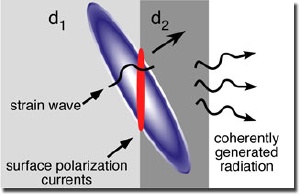Jul 4 2008
Acoustic waves play many everyday roles - from communication between people to ultrasound imaging. Now the highest frequency acoustic waves in materials, with nearly atomic-scale wavelengths, promise to be useful probes of nanostructures such as LED lights.
 Electromagnetic radiation is produced when an acoustic wave (purple) generates electric currents (red) as it propagates past an interface between two piezoelectric materials. The radiation propagates outside of the materials and can be detected to determine the shape of the acoustic wave with nearly atomic scale resolution.
Electromagnetic radiation is produced when an acoustic wave (purple) generates electric currents (red) as it propagates past an interface between two piezoelectric materials. The radiation propagates outside of the materials and can be detected to determine the shape of the acoustic wave with nearly atomic scale resolution.
However, detecting them isn’t so easy.
Enter Lawrence Livermore National Laboratory scientists, who discovered a new physical phenomenon that enables them to see high frequency waves by combining molecular dynamics simulations of shock waves with an experimental diagnostic, terahertz (THz) radiation. (The hertz is the base unit of frequency. One hertz simply means one cycle per second. A terahertz is 10^12 hertz.).
The Livermore scientists performed computer simulations of the highest frequency acoustic waves forming spontaneously at the front of shock waves or generated by sub-picosecond pulse-length lasers.
They discovered that, under some circumstances, when such a wave crosses an interface between two materials, tiny electric currents are generated at the interface. These currents produce electromagnetic radiation of THz frequencies that can be detected a few millimeters away from the interface. Part of the wave is effectively converted to electromagnetic radiation, which propagates out of the material where it can be measured.
Most molecular dynamics simulations of shock waves connect to experiments through electronic properties, such as optical reflectivity.
“But this new approach connects to the much lower frequency THz radiation produced by the individual atoms moving around in the shock wave,” said Evan Reed, lead author of a paper that appears in the July 7 edition of the journal, Physical Review Letters. “This kind of diagnostic promises to provide new information about shocked materials like the dynamics of crystals pushed to ultra-high strain rates.”
Using molecular dynamics simulations, the team, made up of Livermore’s Reed and Michael Armstrong in collaboration with Los Alamos National Laboratory colleagues shows that the time-history of the wave can be determined with potentially sub-picosecond, nearly atomic time and space resolution by measuring the electromagnetic field.
Reed and colleagues studied the effect for an interface between two thin films, which are used in LED (light-emitting diode) nanostructures, and are piezoelectric (electric currents that are generated when they are squeezed). Piezoelectric materials have been used for decades as arrival time gauges for shock-wave experiments but have been limited by electrical equipment that can only detect acoustic frequencies less than 10 gigathertz (GHz), precluding observation of the highest frequency acoustic waves. The new THz radiation technique can help improve the time resolution of such approaches.
The technique has other applications as well. It can be applied to determine the structure of many kinds of electronic devices that are constructed using thin film layered structures, such as field-effect transistors.
“The detection of high frequency acoustic waves also has been proposed for use in imaging of quantum dot nanostructures used in myriad optical devices, possibly including solar cells in the future,” Reed said. “The technology is not there yet for that application, but our work represents a step closer.”